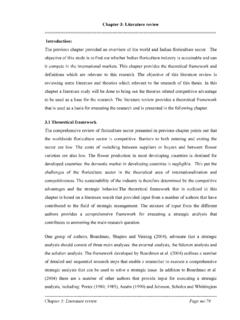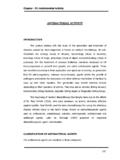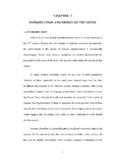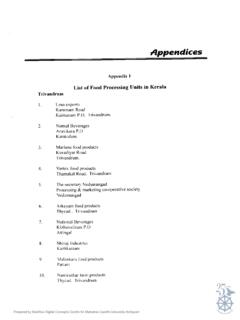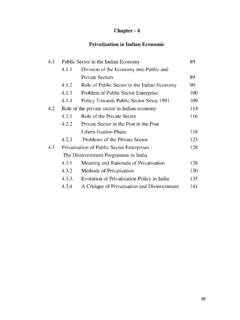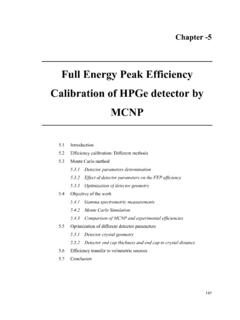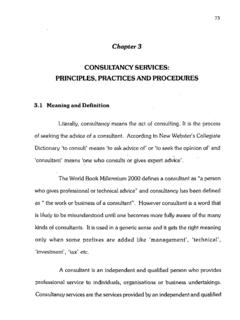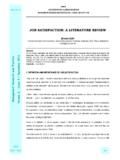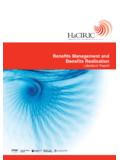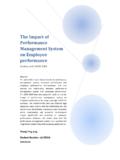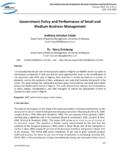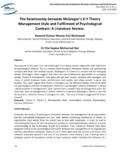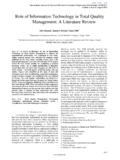Transcription of REVIEW OF LITERATURE - Shodhganga
1 CHAPTER 3. REVIEW OF LITERATURE . INTORDUCTION: REVIEW of LITERATURE has vital relevance with any research work due to LITERATURE REVIEW the possibility of repetition of study can be eliminated and another dimension can be selected for the study. The LITERATURE REVIEW helps researcher to remove limitations of existing work or may assist to extend prevailing study. Several research have been conducted to analyse the different aspects of performance of commercial banks in India and abroad. But there are very few research and LITERATURE available on the subject related to financial reforms and its impact on Indian banks. The available LITERATURE and research are divided into four major parts according to the area of research LITERATURE related to: 1. REVIEW of LITERATURE related to Performance Appraisal of Banks 2.
2 REVIEW of LITERATURE related to Policy Framework and Recommendations for Banks 3. REVIEW of LITERATURE related to Impact of Reforms on Indian Banks 4. REVIEW of LITERATURE related to Service Quality of Indian Banks2. The above mentioned LITERATURE have been obtained from following four major sources such as (i) research conducted in India, (ii) The research /. studies carried over by the institutions like RBI, ICRA Limited and business magazines like Financial Express, Business Today, Money Outlook, Business India, etc. and (iii) Research Studies of individual scholars published in journals and magazines and (iv) websites of RBI, Govt. of India and websites of various banks. The present study is undertaken in the light of the methodology adopted and conclusions emerged in the earlier studies relating to the performance evaluation, financial reforms and their impact on the Indian banking sector.
3 And a comparison between the two. 32. REVIEW RELATED TO DEVELOPMENT & PERFORMANCE. MEASURES. Prashanta Athma (2000), in his Ph D research submitted at Usmania University Hyderabad, Performance of Public Sector Banks A Case Study of State Bank of Hyderabad, made an attempt to evaluate the performance of Public Sector Commercial Banks with special emphasis on State Bank of Hyderabad. The period of the study for evaluation of performance is from 1980 to 1993-94, a little more than a decade. In this study, Athma outlined the Growth and Progress of Commercial Banking in India and. analyzed the trends in deposits, various components of profits of SBH, examined the trends in Asset structure, evaluated the level of customer satisfaction and compared the performance of SBH with other PSBs, Associate Banks of SBI and SBI.
4 Statistical techniques like Ratios, Percentages, Compound Annual rate of growth and averages are computed for the purpose of meaningful comparison and analysis. The major findings of this study are that since nationalization, the progress of banking in India has been very impressive. All three types of Deposits have continuously grown during the study period, though the rate of growth was highest in fixed deposits. A comparison of SBH performance in respect of resource mobilization with other banks showed that the average growth of deposits of SBH is higher than any other bank group. Profits of SBH. showed an increasing trend indicating a more than proportionate increase in spread than in burden. Finally, majority of the customers have given a very positive opinion about the various statements relating to counter service offered by SBH.
5 Zacharias Thomas(1997)Ph D Thesis, Performance effectiveness of Nationalised Bank- A Case Study of Syndicate Bank', submitted to Kochin University (1997), Thesis studied the performance effectiveness of Nationalized Bank by taking Syndicate Bank as case study in his thesis. Thomas has examined various aspects like growth and development of banking industry, achievements of Syndicate Bank in relation to capital adequacy, quality of assets, Profitability, Social Banking, Growth, Productivity, Customer Service and also made a comparative analysis of 'the performance 33. effectiveness of Syndicate Bank in relation to Nationalized bank. A period of ten years from 1984 to 1993-94 is taken for the study. This study is undertaken to REVIEW and analyze the performance effectiveness of Syndicate Bank and other Nationalized banks in India using an Economic Managerial- Efficiency Evaluation Model (EMEE Model) developed by researcher.
6 Thomas in this study found that Syndicate Bank got 5th Position in Capital adequacy and quality of assets, 15th in Profitability, 14th Position in Social Banking, 8th in Growth, 7th in Productivity and 15th position in Customer Service among the nationalized banks. Further, he found that five nationalized banks showed low health performance, seven low priority performance and eleven low efficiency performance in comparison with Syndicate Bank. Singh R (2003), in his paper Profitability management in banks under deregulate environment, IBA bulletin, No25, has analyzed profitability management of banks under the deregulated environment with some financial parameters of the major four bank groups public sector banks, old private sector banks, new private sector banks and foreign banks, profitability has declined in the deregulated environment.
7 He emphasized to make the banking sector competitive in the deregulated environment. They should prefer non- interest income sources. Singla HK (2008), in his paper,' financial performance of banks in India,'. in ICFAI Journal of Bank Management No 7, has examined that how financial management plays a crucial role in the growth of banking. It is concerned with examining the profitability position of the selected sixteen banks of banker index for a period of six years (2001-06). The study reveals that the profitability position was reasonable during the period of study when compared with the previous years. Strong capital position and balance sheet place, Banks in better position to deal with and absorb the economic constant over a period of time. The focal point of the study made by Das and Udaykumar Lal (2002), in his book Banking Reforms in Lead Bank Scheme, (Deep and Deep Publication, new Delhi) was the critical evaluation of the lead bank scheme in 34.
8 The light of banking sector reforms. Das in this book observed that high level of NPAs, large number of un-remunerative branches, low productivity, overstaff and archaic methods of operations have affected the profitability of public sector banks. Das sincerely felt that the whole banking sector in India is to be revolutionized to cope with the changing dimensions of the satellite one world. Further, he felt that the backward areas should be given more funds for investment in priority sectors and more and more people should be brought under its coverage and the procedures of extending credit should be simplified and there should be least hassle cost. Subramanian and Swami (1994) in their paper, Comparative performance of publc sector banks in india Prjanan, Vol.
9 XXII, have analyzed and compared the efficiency in six public sector banks, four private sector and three foreign banks for the year 1996-97. Operational efficiency is calculatedin terms of total business and salary expenditure per employee. The analysis revealed that higher per employee salary level need not result in poor efficiency and business per employee efficiency co-efficient was also calculated. Among the PSBs, Bank of Baroda registered the high efficiency and operating profit per employee. Among the private sector banks Indus Bank followed by Citibank Registered highest and second highest operating profit per employee respectively. However, among the Nationalized Banks there existed wide variations in efficiency. Frequent changes are order of the day for the topics of this nature.
10 Therefore, one should rely on latest information. Some organizations like, RBI, IBA, SBI and ICRA have carried out several research studies on various issues relating to banking and exclusive banking journals/periodicals like Bank Quest, The Bankers, RBI occasional papers, RBI bulletins and general magazines like Business Today, Business India, Finance India, have been publishing papers on various aspects like NPAs, capital adequacy, branch expansion, credit dispensation, deposit mobilization, service quality, technology, performance evaluation, etc. Same studies and papers suitable to this study are being reviewed here. 35. SBI Research Department in 2000, through its paper Performance analysis of 27 Public sector banks published in SBI monthly REVIEW performance, Vol XXXIX, was prepared by Economic Research Department of State Bank of India, is to analyze the Performance of the 27 Public Sector Banks for the year 1999-2000 vis-a-vis the preceding year.
